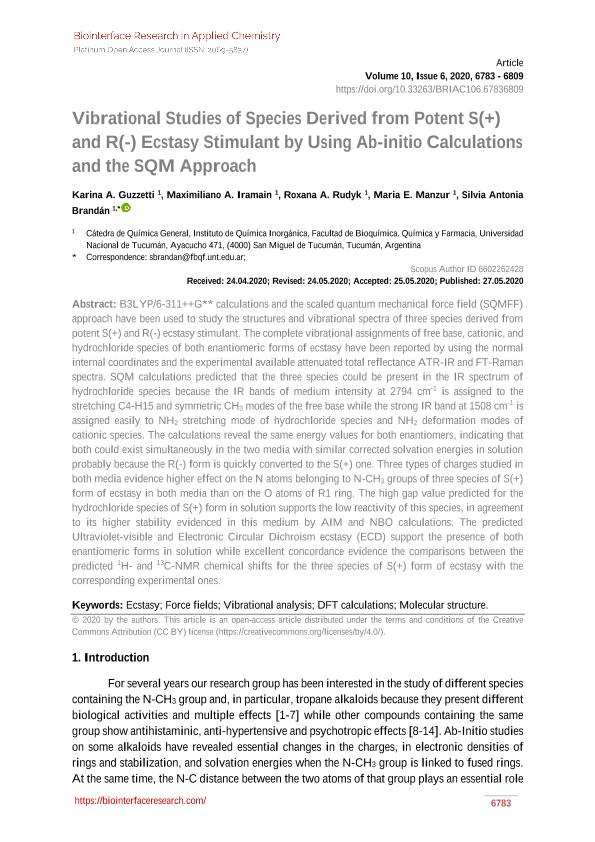Artículo
Vibrational studies of species derived from potent S(+) and R(-) ecstasy stimulant by using ab-initio calculations and the SQM approach
Guzzetti, Karina Andrea; Iramain, Maximiliano Alberto ; Rudyk, Roxana Amelia; Manzur, Maria Eugenia; Brandan, Silvia Antonia
; Rudyk, Roxana Amelia; Manzur, Maria Eugenia; Brandan, Silvia Antonia
 ; Rudyk, Roxana Amelia; Manzur, Maria Eugenia; Brandan, Silvia Antonia
; Rudyk, Roxana Amelia; Manzur, Maria Eugenia; Brandan, Silvia Antonia
Fecha de publicación:
12/2020
Editorial:
AMG Transcend Association
Revista:
Biointerface Research in Applied Chemistry
e-ISSN:
2069-5837
Idioma:
Inglés
Tipo de recurso:
Artículo publicado
Clasificación temática:
Resumen
B3LYP/6-311++G** calculations and the scaled quantum mechanical force field (SQMFF) approach have been used to study the structures and vibrational spectra of three species derived from potent S(+) and R(-) ecstasy stimulant. The complete vibrational assignments of free base, cationic, and hydrochloride species of both enantiomeric forms of ecstasy have been reported by using the normal internal coordinates and the experimental available attenuated total reflectance ATR-IR and FT-Raman spectra. SQM calculations predicted that the three species could be present in the IR spectrum of hydrochloride species because the IR bands of medium intensity at 2794 cm-1 is assigned to the stretching C4-H15 and symmetric CH3 modes of the free base while the strong IR band at 1508 cm-1 is assigned easily to NH2 stretching mode of hydrochloride species and NH2 deformation modes of cationic species. The calculations reveal the same energy values for both enantiomers, indicating that both could exist simultaneously in the two media with similar corrected solvation energies in solution probably because the R(-) form is quickly converted to the S(+) one. Three types of charges studied in both media evidence higher effect on the N atoms belonging to N-CH3 groups of three species of S(+) form of ecstasy in both media than on the O atoms of R1 ring. The high gap value predicted for the hydrochloride species of S(+) form in solution supports the low reactivity of this species, in agreement to its higher stability evidenced in this medium by AIM and NBO calculations. The predicted Ultraviolet-visible and Electronic Circular Dichroism ecstasy (ECD) support the presence of both enantiomeric forms in solution while excellent concordance evidence the comparisons between the predicted1H-and13C-NMR chemical shifts for the three species of S(+) form of ecstasy with the corresponding experimental ones.
Archivos asociados
Licencia
Identificadores
Colecciones
Articulos(CCT - NOA SUR)
Articulos de CTRO.CIENTIFICO TECNOL.CONICET - NOA SUR
Articulos de CTRO.CIENTIFICO TECNOL.CONICET - NOA SUR
Citación
Guzzetti, Karina Andrea; Iramain, Maximiliano Alberto; Rudyk, Roxana Amelia; Manzur, Maria Eugenia; Brandan, Silvia Antonia; Vibrational studies of species derived from potent S(+) and R(-) ecstasy stimulant by using ab-initio calculations and the SQM approach; AMG Transcend Association; Biointerface Research in Applied Chemistry; 10; 6; 12-2020; 6783-6809
Compartir
Altmétricas



